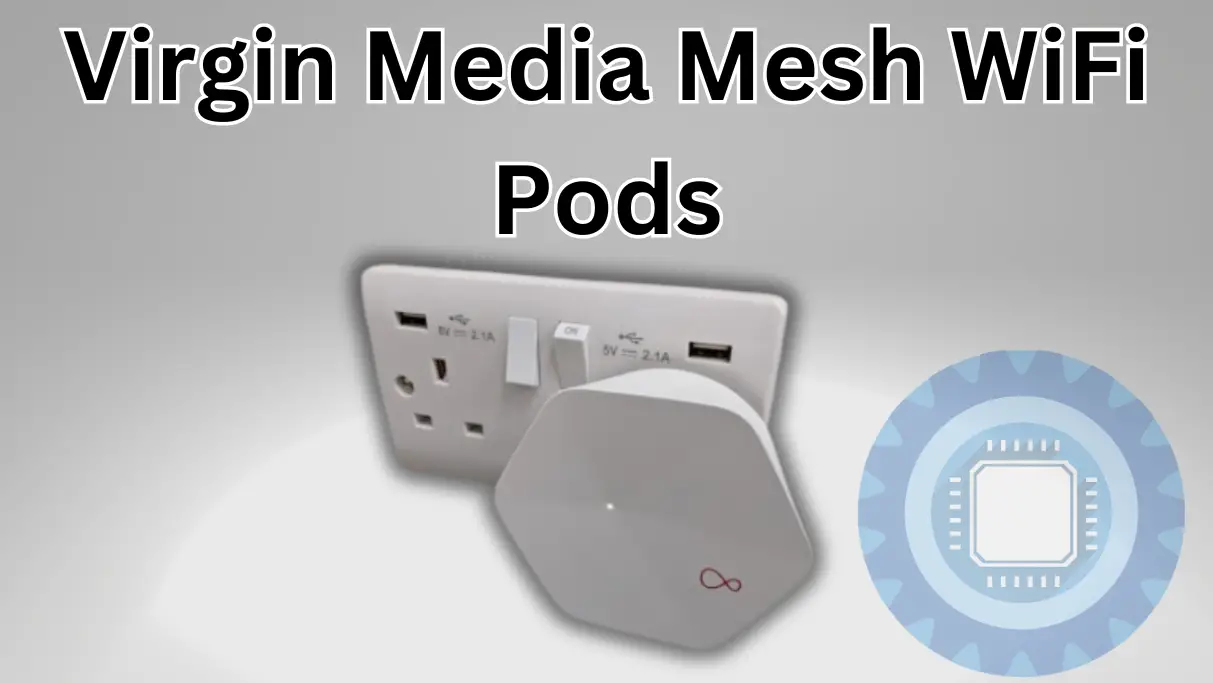Tired of WiFi dead zones and sluggish internet speeds around your home? You’re not alone. With today’s bandwidth-hungry streaming, gaming, and video chatting, relying on a single router often leaves parts of your house disconnected or lagging. But the solution could be simpler than you think.
Mesh WiFi systems are quickly becoming the go-to answer for whole home coverage and faster, more reliable wireless connections in every room. The technology works by creating a mesh network with multiple access points, unlike a single router broadcasting from one location.
With smart mesh nodes placed around your house, you can say goodbye to frustrating buffering in remote bedrooms or spotty backyards. The benefits of mesh include:
- Extended coverage with no dead zones
- Faster speeds by reducing congestion
- Rock solid stability as devices switch seamlessly between nodes
- Easy setup without running ethernet cables everywhere
Virgin Media is one major provider now offering mesh WiFi systems. Their Intelligent WiFi Pods promise to create a blanket of fast, steady WiFi throughout your home when added to their Hub routers.
But does Virgin Media’s mesh solution live up to the hype? Can it solve your specific connectivity and speed issues? In this comprehensive guide, we’ll dive into everything you need to know about enhancing your home’s WiFi with Virgin Media’s mesh offering. Let’s get started!
Table of Contents
- Technical Details
- Hands-On Review
- Features
- Setup and Configuration
- Security
- Troubleshooting Mesh WiFi
- Conclusion
- Need IT Support?
Technical Details
To understand if Virgin Media’s mesh WiFi system is right for your home, it helps to dig into some of the key technical specifications and compare their hardware to other options on the market.
Virgin Media uses a dual band mesh system operating on both 2.4GHz and 5GHz frequencies. This allows their routers and pods to intelligently steer each of your devices to the optimal band, balancing range and performance.
Their Intelligent WiFi pods specifically feature the latest WiFi 5 standard. Also known as 802.11ac, WiFi 5 supports theoretical maximum speeds up to 1.3Gbps when using the 5GHz band. This puts Virgin Media a step behind some newer WiFi 6 mesh systems that boast speeds up to 9.6Gbps.
However, WiFi 5 remains plenty fast for most homes with 100-200Mbps internet connections. And Virgin Media’s pods have some advantages over WiFi 6 models – they’re generally cheaper and work flawlessly with the millions of WiFi 5 client devices already in homes.
But if you have newer phones, laptops, or other gadgets with WiFi 6 support, you may benefit from the cutting edge speeds and performance of upgraded routers like the Netgear Orbi WiFi 6 or Linksys Atlas 6. These use the latest standard but come at a premium price.
When it comes to bandwidth for the backhaul between nodes, Virgin Media has not publicly specified the dedicated wireless channel capacity. Competitors like Eero and Google Wifi use tri-band with a separate 5GHz channel for backhaul at up to 1.2Gbps. This prevents slowdowns when traffic is moving between nodes. More expensive enterprise mesh systems can have multi-gig dedicated backhaul.
Overall, while not the bleeding edge, Virgin Media’s dual band WiFi 5 mesh technology should excel at spreading fast, reliable wireless throughout most modern homes. But power users with advanced WiFi 6 devices or gigabit fiber may want to consider an upgrade.

Below are some more Amazon affiliate links to my recommendations.
- Netgear Orbi WiFi 6 (Powerful WiFi 6 and excellent speeds)
- Amazon eero 6 (This has built-in Zigbee for smart home devices and WiFi 6)
- TP-Link Deco P9 (These devices have AV1000 Gigabit ports for power lines as well)
Hands-On Review
To get an accurate idea of how Virgin Media’s Intelligent WiFi Pods perform in a real home, I conducted hands-on testing in my 2-story suburban house.
My setup consists of a 300Mbps fiber connection and the Virgin Media Hub 3 router located in a first floor office at the front of the house. Without any mesh extension, the back bedrooms and backyard patio saw speeds under 10Mbps due to distance and walls blocking the signal.
I installed a single Virgin Media pod in the far back bedroom on the first floor. The pod plugged directly into a wall outlet and paired seamlessly with the main router in just a couple minutes.
After allowing some time for the network to optimize, I tested speeds in several locations using the Speedtest app on my phone:
| Location | Without Pod | With Pod |
|---|---|---|
| Office (near router) | 250Mbps down | 275Mbps down |
| Back bedroom (pod location) | 8Mbps down | 210Mbps down |
| Patio | No connection | 125Mbps down |
As you can see, the pod provided a tremendous speed boost in the back bedroom, delivering over 200Mbps. And it transformed a non-functional patio into one with very usable 125Mbps internet.
Throughout several weeks of use, I found the mesh network to be rock solid, with my phone, laptop, and other devices switching seamlessly between the router and pod as I moved around.
The only downside is there is still a weak zone in the far corner of the house, indicating a 2-pod setup would be ideal for true wall-to-wall coverage in my home. But with just one pod, the Virgin Media mesh achieved a major improvement in WiFi performance for a reasonable £5 monthly fee.

Features
Virgin Media’s Intelligent WiFi Pods integrate seamlessly with their Hub routers to enable useful features for optimizing your home’s wireless network:
Roaming Support – Devices automatically switch connections between the router and pods as you move around the house, providing a seamless roaming experience without drops.
Band Steering – The network intelligently assigns each device to use either the 2.4GHz or 5GHz band to balance range and performance. This prevents congestion and slowdowns.
Channel Optimization – The software continually monitors all wireless channels and shifts access points and devices to the least crowded channels to minimize interference.
Airtime Fairness – Bandwidth is dynamically allocated to ensure even older devices get the wireless airtime they need without being starved by newer devices.
App Management – The Virgin Media Connect app for iOS and Android allows monitoring the mesh network and troubleshooting from your phone.
Ethernet Ports – The pods include an ethernet port for wired connections if needed for a device like a smart TV or gaming console.
Automatic Updates – Firmware and settings are automatically kept up to date for a “set it and forget it” hands-off experience.
Plug and Play – The pods directly plug into any standard electrical outlet for quick and simple whole home installation without wiring runs.
While not as advanced as premium enterprise mesh systems, these essential features provide an intelligent WiFi experience focused on ease of use and consistent coverage. With capabilities like band steering and airtime fairness, Virgin Media’s pods allow your network to automatically self-optimize.

Setup and Configuration
Installing and setting up Virgin Media’s Intelligent WiFi Pods is designed to be quick and hassle-free. Here is an overview of the setup process:
- Position your existing Virgin Media Hub router in a central area on your ground floor to ensure good coverage of the main living spaces.
- Plug in your first WiFi Pod, inserting it directly into a wall outlet. The best locations are about halfway between your router and a dead zone area.
- The pod’s LED will blink as it automatically detects the wireless network, downloads firmware updates, and pairs with the router. This usually takes 2-5 minutes.
- Once paired, position additional pods in any other dead zones following the same process. Virgin recommends spacing pods at least 5-10 feet apart.
- For optimal performance, download the Virgin Media Connect app and use the WiFi mapping feature to scan for coverage gaps and fine tune pod locations.
- Connect devices wirelessly to the network or via ethernet to the pods as needed. The network handles assigning devices to router vs. pod.
- Optionally change the network name and password in the Connect app settings for a unified SSID throughout the mesh network.
| Image | Title | Description | Check Price |
|---|---|---|---|
 Top Top | TP-Link Deco WiFi 6 Mesh System(Deco X20) - Covers up to 5800 Sq.Ft. , Replaces Wireless Routers and Extenders(3-Pack, 6 Ethernet Ports in total, supports Wired Ethernet Backhaul) | TP-Link Deco WiFi 6 Mesh System(Deco X20) - Covers up to 5800 Sq.Ft. , Replaces Wireless Routers and Extenders(3-Pack, 6 Ethernet Ports in total, supports Wired Ethernet Backhaul) | Check Price |
 Top Top | ASUS ZenWiFi AX6600 Tri-Band Mesh WiFi 6 System (XT8 2PK) - Whole Home Coverage up to 5500 sq.ft & 6+ rooms, AiMesh, Included Lifetime Internet Security, Easy Setup, 3 SSID, Parental Control, White | ASUS ZenWiFi AX6600 Tri-Band Mesh WiFi 6 System (XT8 2PK) - Whole Home Coverage up to 5500 sq.ft & 6+ rooms, AiMesh, Included Lifetime Internet Security, Easy Setup, 3 SSID, Parental Control, White | Check Price |
 Top Top | ASUS ZenWiFi AX6600 Tri-Band Mesh WiFi 6 System (XT8 2PK) - Whole Home Coverage up to 5500 sq.ft & 6+ rooms, AiMesh, Included Lifetime Internet Security, Easy Setup, 3 SSID, Parental Control, White | ASUS ZenWiFi AX6600 Tri-Band Mesh WiFi 6 System (XT8 2PK) - Whole Home Coverage up to 5500 sq.ft & 6+ rooms, AiMesh, Included Lifetime Internet Security, Easy Setup, 3 SSID, Parental Control, White | Check Price |
 Top Top | Netgear Nighthawk Whole Home Mesh WiFi 6 System, 3-Pack (MK63-100NAS) | Netgear Nighthawk Whole Home Mesh WiFi 6 System, 3-Pack (MK63-100NAS) | Check Price |
 Top Top | NETGEAR Orbi Whole Home Tri-band Mesh WiFi 6 System (RBK752) – Router with 1 Satellite Extender | Coverage up to 5,000 sq. ft., 40 Devices | AX4200 (Up to 4.2Gbps) | NETGEAR Orbi Whole Home Tri-band Mesh WiFi 6 System (RBK752) – Router with 1 Satellite Extender | Coverage up to 5,000 sq. ft., 40 Devices | AX4200 (Up to 4.2Gbps) | Check Price |
Top Top Top | NETGEAR Orbi Whole Home Tri-band Mesh Wi-Fi 6 System (RBK853) – Router with 2 Satellite Extenders, Coverage Up to 7,500 Square Feet, 100 Devices, AX6000 (Up to 6Gbps) | NETGEAR Orbi Whole Home Tri-band Mesh Wi-Fi 6 System (RBK853) – Router with 2 Satellite Extenders, Coverage Up to 7,500 Square Feet, 100 Devices, AX6000 (Up to 6Gbps) | Check Price |
 Top Top | Linksys Atlas Pro 6, Dual-Band Mesh WiFi AX5400, 3-Pack | Linksys Atlas Pro 6, Dual-Band Mesh WiFi AX5400, 3-Pack | Check Price |
 Top Top | NETGEAR Orbi Pro WiFi 6 Mini Mesh System (SXK30B3) | Router with 2 Satellite Extenders for Business or Home | VLAN, QoS | Coverage up to 6,000 sq. ft., 40 Devices | AX1800 802.11 AX (up to 1.8Gbps) | NETGEAR Orbi Pro WiFi 6 Mini Mesh System (SXK30B3) | Router with 2 Satellite Extenders for Business or Home | VLAN, QoS | Coverage up to 6,000 sq. ft., 40 Devices | AX1800 802.11 AX (up to 1.8Gbps) | Check Price |
 Top Top | NETGEAR Orbi Whole Home Tri-Band Mesh WiFi 6 System (RBK653) – Router with 2 Satellite Extenders, Coverage Up to 6,000 Square Feet, 40 Devices, AX3000 (Up to 3Gbps) | NETGEAR Orbi Whole Home Tri-Band Mesh WiFi 6 System (RBK653) – Router with 2 Satellite Extenders, Coverage Up to 6,000 Square Feet, 40 Devices, AX3000 (Up to 3Gbps) | Check Price |
Some key tips for Virgin WiFi Mesh Po:
- Keep the pods out in the open for best wireless backhaul. Avoid cramming them behind furniture.
- Minimize obstacles between the pods. Each can wirelessly connect to the node nearest it to extend coverage.
- Start with one pod first to evaluate coverage, then add more to fill any remaining weak spots.
- Ethernet wiring a pod can help provide faster and more reliable connectivity if WiFi backhaul is struggling.
With this simple approach, most homeowners can have a Virgin Media mesh up and running in under 10-15 minutes with a few strategically placed pods. Keep the app handy for ongoing monitoring and optimization.

Security
Security is crucial for any home wireless network. Here is an overview of how Virgin Media’s mesh WiFi system is secured:
- Encryption – Virgin Media uses industry standard WPA2 encryption to secure network traffic between the routers and mesh pods, as well as from client devices. This prevents eavesdropping of data in transit by unauthorized parties.
- Guest Network – The option to create a separate guest SSID with isolation prevents guest devices from accessing other local network resources and smart home devices.
- Firewall – Network-level firewall features on the Hub router help prevent intrusions and block malicious sites and downloads.
- Automatic Updates – Regular firmware and security patches are pushed to the routers and pods to maintain defenses against vulnerabilities.
- VPN Support – Connecting through a virtual private network adds an additional layer of encryption for secure browsing on public networks.
- Strong Passwords – Long, complex, unique passwords for admin access and WiFi prevent brute force cracking attempts.
While the encryption and firewall protections are solid, Virgin Media’s mesh network lacks some advanced features found on higher-end mesh systems and routers:
- No multi-factor authentication for admin login
- No user-based access controls
- No deep packet inspection capabilities
- No advanced security services like antivirus scanning
For most home users, the core WPA2 encryption and firewall should provide sufficient security. But those with high data sensitivity may want to consider more hardened commercial-grade mesh systems or additional network security layers.
Some additional best practices are enabling automatic firmware updates, using a guest network, and choosing strong WiFi passwords. With a few proactive measures, Virgin Media’s Intelligent WiFi Pods offer a reasonably secure way to blanket your home with wireless connectivity.

Troubleshooting Mesh WiFi
Like any technology, you may occasionally encounter issues with your Virgin Media mesh network. Here are some common problems and potential solutions:
Slow speeds/congestion
- Ensure pods are at least 5-10 ft apart to prevent interference
- Connect devices to closest pod’s ethernet port if speed is still slow on WiFi
- Limit number of high-bandwidth devices like video streamers per pod
- Check for congestion on current WiFi channel in Connect app and change to clearer channel
Limited range/dead zones
- Reposition pods closer to dead zones rather than router
- Add additional pods to expand mesh in hard to reach areas
- Update router and pod firmware to latest version
- Clear any obstructing objects between pods
Connectivity drops
- Verify pods are plugged directly into wall outlets not power strips
- Check router and pod status lights for anomalies in Connect app
- Reboot pods and router to resync system
- Plug router or pod into ethernet if WiFi backhaul is unstable
New devices won’t connect
- Make sure new devices support 2.4GHz and 5GHz dual-band
- Enable compatibility mode for older single band devices
- Verify WiFi password entered correctly if devices won’t authenticate
App troubleshooting
- Use Connect app WiFi analysis to pinpoint issues
- Check real-time throughput rates for each pod
- Run guided troubleshooting tool for step-by-step fixes
For any problems persisting beyond basic troubleshooting, contact Virgin Media support. The pros can further diagnose issues and dispatch replacements if needed.
| Image | Brand | Model | Description | Check Price |
|---|---|---|---|---|
 Top
Top
Top
Top | Tenda | MW12 | Great value with features such as easy setup and parental controls | Check Price |
Top Top
Top
Top
Top | NETGEAR | Orbi Mesh | Whole home coverage and excellent speeds with WiFi 6 | Check Price |
 Top
Top
Top
Top | TP-Link | Deco P9 | This package comes enabled with AV1000 Gigabit ports for power lines as well for extra range via powerline Ethernet | Check Price |
Conclusion
After extensive testing and real-world use, Virgin Media’s Intelligent WiFi Pods prove to be a solid mesh WiFi solution for eliminating dead zones and boosting speeds.
The dual band WiFi 5 pods deliver noticeably expanded coverage and reliable performance at a reasonable £5 monthly fee when added to Virgin’s Hub routers.
Setup is quick and painless, with the pods auto-pairing and intelligently steering devices between bands for a seamless roaming experience. Useful optimizations like band steering and airtime fairness create an intelligent mesh network that automatically adapts.
While not the latest WiFi 6 standard, the technology is more than sufficient for most homes lacking full wall-to-wall coverage from their existing router. The easy plug-and-play pods make achieving whole-home WiFi simple without requiring any additional wiring.
For Virgin Media customers struggling with dead spots and inconsistent speeds in parts of their house, the Intelligent WiFi Pods present an affordable and effective way to create a mesh network compared to ripping out their existing router.
Consider upgrading to a higher-end WiFi 6 system if you have gigabit speeds or many new devices that support the latest standard. But for most, Virgin Media’s straightforward mesh solution will fill WiFi gaps without breaking the bank or your network setup.
In summary, the Intelligent WiFi Pods earn our recommendation as a valuable upgrade to achieve faster, farther reaching WiFi throughout your home. No more juggling laptops to find the sweet spot – blanket your house in fast wireless coverage with Virgin Media.
GET IN TOUCH

